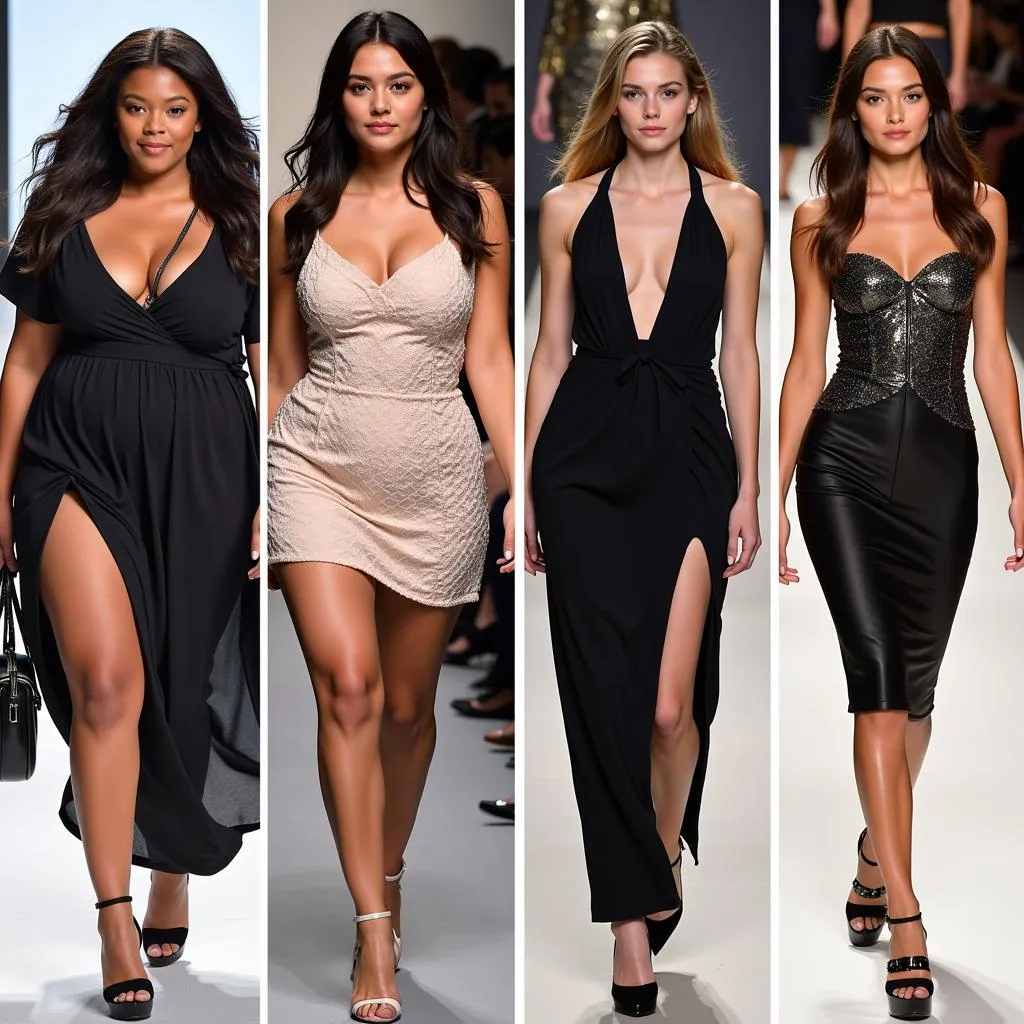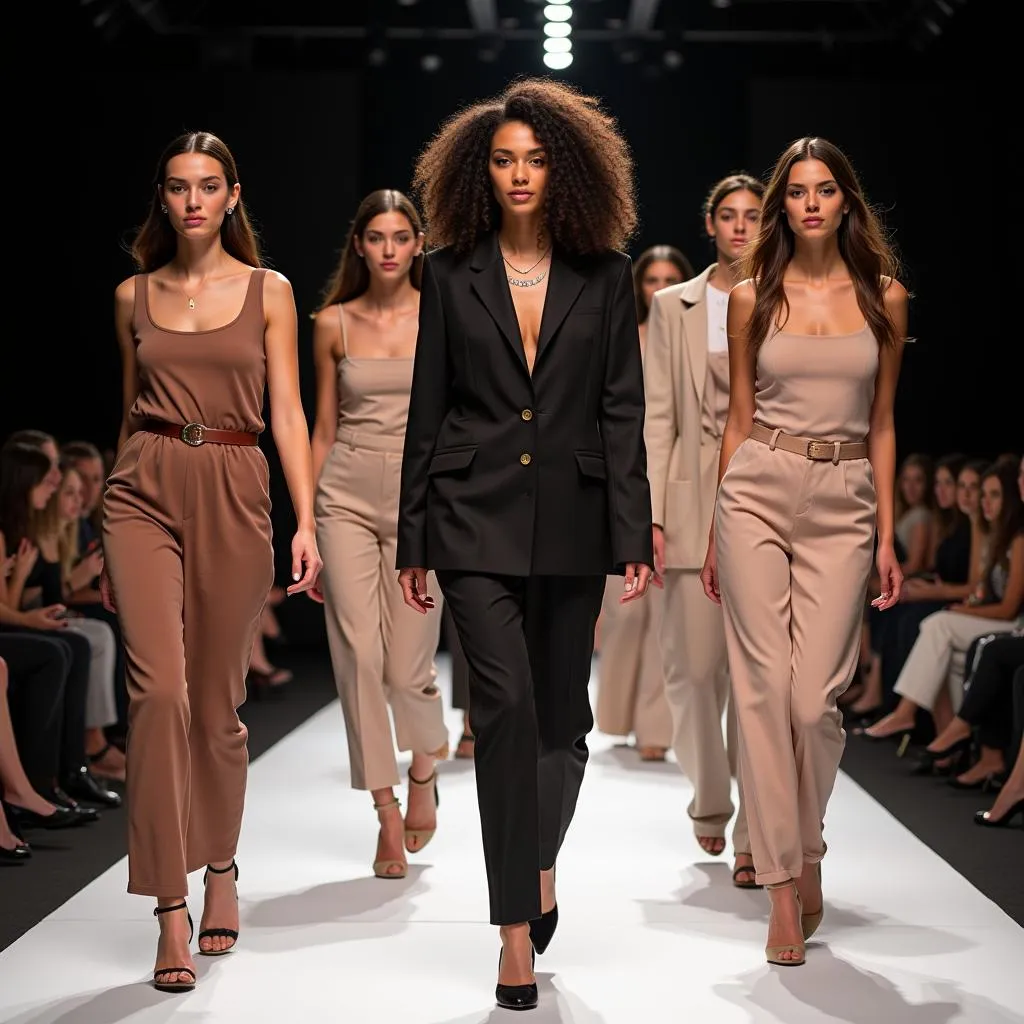The fashion industry’s impact on body image is a recurring topic in IELTS Writing Task 2, appearing with moderate frequency in past exams. Its relevance to social issues and potential for diverse perspectives make it a prime candidate for future tests. Let’s explore this theme through a sample question that closely resembles those seen in actual IELTS exams.
Some people believe that the fashion industry has a negative influence on people’s perceptions of body image. To what extent do you agree or disagree with this statement?
Analyzing the Question
This question requires candidates to express their opinion on the fashion industry’s impact on body image perceptions. Key points to consider:
- The main topic: The influence of the fashion industry on body image
- The task: Agree or disagree with the statement
- The scope: The extent of agreement or disagreement
A well-structured response should clearly state the writer’s position, provide relevant examples, and discuss the extent of the fashion industry’s influence on body image perceptions.
Sample Essay 1 (Band 8-9)
The fashion industry wields significant influence over societal perceptions of body image, and I strongly agree that this impact is predominantly negative. This essay will explore the extent of this influence and its detrimental effects on individuals’ self-image and mental health.
Firstly, the fashion industry perpetuates unrealistic beauty standards through its choice of models and advertising campaigns. Runways and fashion magazines are dominated by extremely thin or perfectly toned bodies, which are often digitally altered to appear flawless. This relentless promotion of an idealized physique creates an unattainable standard for the average person, leading to feelings of inadequacy and low self-esteem. For instance, a study by the National Eating Disorders Association found that exposure to fashion media significantly increased body dissatisfaction among young women.
Moreover, the industry’s focus on specific body types marginalizes diversity and promotes a narrow definition of beauty. By predominantly featuring one body type, the fashion world implicitly suggests that other body shapes and sizes are less desirable or fashionable. This lack of representation can have far-reaching consequences, particularly for young people who are still developing their sense of self-worth. The pressure to conform to these standards can lead to unhealthy behaviors, including extreme dieting and even eating disorders.
However, it is important to acknowledge that some segments of the fashion industry are making efforts to promote body positivity and inclusivity. In recent years, there has been a growing trend towards featuring more diverse body types in advertising and on runways. Some brands are actively championing body positivity, using models of various sizes, ages, and ethnicities. While these efforts are commendable, they remain the exception rather than the rule in an industry that still largely adheres to traditional beauty standards.
In conclusion, while there are some positive initiatives within the fashion industry, its overall influence on body image perceptions remains overwhelmingly negative. The pervasive promotion of unrealistic beauty ideals and the marginalization of diverse body types continue to have detrimental effects on individuals’ self-image and mental well-being. To mitigate these negative impacts, it is crucial for the fashion industry to embrace genuine diversity and promote a more inclusive representation of beauty.
 Fashion industry's influence on body image perceptions
Fashion industry's influence on body image perceptions
Sample Essay 2 (Band 6-7)
In my opinion, the fashion industry does have a negative influence on people’s perceptions of body image to a large extent. This essay will discuss the reasons for this view.
One of the main ways the fashion industry negatively affects body image is through its use of very thin models. Most fashion shows and advertisements feature models who are much thinner than the average person. This can make people feel bad about their own bodies if they don’t look like these models. For example, many young girls might try to lose weight in unhealthy ways to look like fashion models they see in magazines.
Another problem is that the fashion industry often promotes certain body types as being more fashionable or desirable. This can make people with different body shapes feel less attractive or out of style. It’s common to see clothes designed for slim figures, which can be discouraging for people with other body types. This lack of diversity in fashion can negatively impact people’s self-esteem.
However, it’s important to note that some fashion brands are trying to be more inclusive. Some companies are now using models of different sizes and shapes in their advertising. This is a positive step towards promoting a healthier body image. For instance, some popular clothing brands have started ‘body positive’ campaigns featuring models of various sizes.
In conclusion, while there are some positive changes happening, I believe the fashion industry still has a largely negative influence on body image perceptions. The continuous promotion of unrealistic body standards affects how people view themselves and can lead to unhealthy behaviors. To improve this situation, the fashion industry should work harder to represent a wider range of body types and promote a more inclusive idea of beauty.
 Body positive fashion campaign featuring diverse models
Body positive fashion campaign featuring diverse models
Sample Essay 3 (Band 5-6)
I think the fashion industry has a bad effect on how people see their bodies. This essay will talk about why I agree with this idea.
First, fashion shows and magazines always use very skinny models. These models are much thinner than normal people. When people see these models, they might feel bad about their own bodies. They might think they need to be very thin to look good. This can make people unhappy with how they look.
Also, fashion companies often make clothes for only one type of body. Many clothes are made for thin people. This can make people with other body shapes feel left out. They might think their body is not good enough for fashionable clothes. This is not fair and can hurt people’s feelings about themselves.
But some fashion brands are trying to do better. Some companies now use models with different body types in their ads. This is good because it shows that all body types can be beautiful. For example, some big clothing stores now have plus-size sections with models who are not very thin.
In conclusion, I think the fashion industry mostly has a bad effect on body image. It makes many people feel bad about how they look. To fix this, fashion companies should use more different types of models and make clothes for all body shapes.
 Diverse fashion models on the runway
Diverse fashion models on the runway
Understanding the Band Scores
Band 8-9 Essay Analysis:
- Task Achievement: The essay fully addresses all parts of the task, presenting a well-developed response with relevant, extended and supported ideas.
- Coherence and Cohesion: Ideas are logically organized with clear progression throughout. Paragraphs are well-linked, and cohesive devices are used effectively.
- Lexical Resource: A wide range of vocabulary is used with very natural and sophisticated control of lexical features. Rare minor errors occur only as ‘slips’.
- Grammatical Range and Accuracy: A wide range of structures is used with full flexibility and accuracy. Rare minor errors occur only as ‘slips’.
Band 6-7 Essay Analysis:
- Task Achievement: The essay addresses all parts of the task, though some parts may be more fully covered than others. The format is appropriate, and the tone is consistent.
- Coherence and Cohesion: Information and ideas are arranged coherently, and there is a clear overall progression. Cohesive devices are used effectively, but cohesion within and/or between sentences may be faulty or mechanical.
- Lexical Resource: An adequate range of vocabulary is used for the task. There may be some inaccuracies in word choice or spelling, but these do not impede communication.
- Grammatical Range and Accuracy: A mix of simple and complex sentence forms is used. There are some errors in grammar and punctuation, but these rarely reduce communication.
Band 5-6 Essay Analysis:
- Task Achievement: The essay addresses the task only partially. The format may be inappropriate in places, and ideas may be inadequately developed or unclear.
- Coherence and Cohesion: The overall progression of ideas is evident, but there may be some repetition or irrelevance. Cohesive devices are used but not always appropriately or accurately.
- Lexical Resource: A limited range of vocabulary is used, with some repetition or inappropriate word choice. Spelling errors may be noticeable.
- Grammatical Range and Accuracy: A limited range of structures is used. Errors in grammar and punctuation are frequent and may cause some difficulty for the reader.
Key Vocabulary to Remember
-
perception (noun) /pəˈsepʃn/: The way in which something is regarded, understood, or interpreted.
-
perpetuate (verb) /pərˈpetʃuˌeɪt/: Make (something) continue indefinitely.
-
marginalize (verb) /ˈmɑːrdʒɪnəˌlaɪz/: Treat (a person, group, or concept) as insignificant or peripheral.
-
diversity (noun) /dəˈvɜːrsəti/: The state of being diverse; variety.
-
inclusivity (noun) /ˌɪnkluˈsɪvəti/: The practice or policy of including people who might otherwise be excluded or marginalized.
-
detrimental (adjective) /ˌdetrəˈmentl/: Tending to cause harm.
-
self-esteem (noun) /ˌself əˈstiːm/: Confidence in one’s own worth or abilities; self-respect.
-
unrealistic (adjective) /ˌʌnriːəˈlɪstɪk/: Not realistic; not based on or mindful of reality.
-
ideology (noun) /ˌaɪdiˈɑːlədʒi/: A system of ideas and ideals, especially one which forms the basis of economic or political theory and policy.
-
influential (adjective) /ˌɪnfluˈenʃl/: Having great influence on someone or something.
In conclusion, the fashion industry’s influence on body image perceptions remains a critical issue in modern society. As we’ve seen through these sample essays, the topic allows for nuanced discussion and varied perspectives. To further enhance your IELTS Writing skills, consider practicing with similar prompts such as:
- Discuss the role of social media in shaping body image perceptions.
- Some people argue that schools should teach about body positivity. Do you agree or disagree?
- To what extent do you think celebrities influence young people’s body image?
Remember, the key to success in IELTS Writing Task 2 is practice. Try writing your own essay on this topic and share it in the comments section below. This active engagement will help you refine your skills and prepare effectively for the IELTS exam.
For more insights on related topics, you might find our articles on fast fashion’s impact on environmental sustainability and sustainable fashion and the future of the industry helpful in broadening your understanding of the fashion industry’s wider impacts.


